Golden Opportunities: Using AuNPs and AI for Detecting Molecular Signatures

The quest for prompt and precise early disease detection tools is glittering with potential. Gold nanoparticles (AuNPs) stand out with their distinctive properties, making them stalwarts in molecular diagnostics. Pair this with the computational might of artificial intelligence (AI), and we're venturing into a groundbreaking realm of detecting cancer's molecular nuances.
Let's chart this fascinating confluence of technology and biology.
Understanding the Power of Gold Nanoparticles
AuNPs aren’t just gold in the literal sense. These minuscule metallic entities are powerhouse performers when it comes to molecular interactions, particularly with nucleic acids. Marry this capability with their unique optical and chemical attributes, and we have a formidable tool in biotechnological pursuits.
Spotting the Invisible: A Focus on cfRNA and cfDNA
Cells, whether healthy or malignant, release genetic tidbits into our bloodstream. These cell-free DNAs (cfDNA) and RNAs (cfRNA) serve as potential harbingers of tumors. But to fish out these minute markers from a deluge of genetic content is a formidable challenge, one that AuNPs are uniquely equipped to handle.
Precision Engineering: Design and Hybridization
- Designing Specific Probes: The secret is in designing tailor-made oligonucleotide probes. When these are complementary to cfRNA or cfDNA target sequences, they offer a precise detection pathway. Infuse these probes with a thiol (-SH) group, and they cozy up to AuNPs, utilizing gold’s affinity for thiol.
- Hybridization: When these probe-armed AuNPs are introduced to a sample, they spring into action, binding eagerly with their complementary cfRNA or cfDNA targets, ensuring a match of utmost precision.
Decoding the Signals with AI: A Deep Dive into Detection
- Colorimetric Detection: It's a play of colors! Depending on target presence, AuNPs can either congregate or scatter, indicating a visible color change. AI's Role: Machine learning models can be trained to discern even the slightest color variations, ensuring high sensitivity in detection.
- Surface-Enhanced Raman Scattering (SERS): AuNPs lend a helping hand, amplifying the usually subtle Raman signals. AI's Role: Advanced algorithms analyze these signals, accurately identifying and quantifying the molecules present, eliminating human error.
- Electrochemical Detection: The realm of electrical signals, where AuNPs relay their interactions in terms of charges. AI's Role: Deep learning can detect patterns in these signals, correlating them with specific cfRNA or cfDNA concentrations, thus enhancing specificity.
- Multiplexing: The beauty of multitasking! Diverse AuNPs, each targeting a distinct genetic marker, work in tandem to detect multiple cfRNAs or cfDNAs. AI's Role: AI systems can segregate and analyze the multitude of signals from different AuNPs, creating a matrix match, ensuring comprehensive detection.
Scaling the Detection: AI’s Magic Touch
- Automated Data Analysis: AI algorithms process vast volumes of data from AuNPs swiftly, ensuring rapid detection.
- Predictive Diagnostics: AI's predictive analytics can forecast potential malignancies, even before overt symptoms manifest.
- Mass Scaling: AI-driven automated platforms can handle numerous samples simultaneously. This means mass screenings, especially in population-dense regions, become feasible, leading to early detection at a community level.
Ensuring Precision: AI-Enhanced Calibration and Validation
For any diagnostic method, authenticity is paramount. AI refines the conditions of detection, ensuring genuine targets are captured, while also trimming down on false positives. Furthermore, through iterative learning, AI models continually refine their accuracy, benchmarking results against known standards and real-world samples.
In Conclusion
With AuNP-based biosensors teaming up with AI, our approach to cancer detection is evolving. It embodies the promise of rapid, pinpoint-accurate, and large-scale diagnostic solutions. Within these miniscule gold particles and intricate algorithms, we find hope and a potential revolution in our fight against cancer.
Member discussion